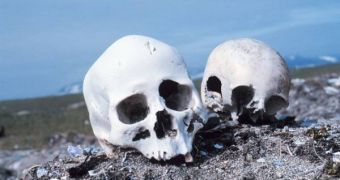The original inhabitants of the Americas may have very well descended from a single ancestor, or from more, partisans of two anthropological theories say. The debate on the issue has been raging on in academic circles for many years, but now newly discovered human skulls, found in Argentina, may finally bring this heated debate to a close. Some say that two types of inhabitants came to South America, in two migration waves. One of these types resembles Northern Asians, while the second looked more like Southern Asians, in terms of face and eye socket appearance.
“We don’t know how people got to the New World, when, or who they were. Those questions are very much up for grabs right now and very controversial,” explains University of California in Santa Cruz (UCSC) anthropologist Judith Habicht-Mauche, quoted by Wired. Some 14,000 years ago, the people in South America (Paleoamericans) resembled more Northern Asians, having long narrow skulls and small eye socket, whereas, some eight millennia ago, the second group (Amerindians) had broader, shorter faces, and larger eye sockets. The reason why these groups were so different from each other are now anyone's guess, but the new finds may help clear some of the mystery.
In a scientific study published in the open-access journal PLoS ONE on Friday, researchers show that mitochondrial DNA evidence points at the fact that the original inhabitants of South America descended from the same Northern Asian ancestor, that came to the continent some 15,000 years ago. The research was conducted by an Argentinian team of experts, from the Universidad Nacional de La Plata, in Buenos Aires, which studied 8,000-year-old bones recovered from a site in the central part of the country. They cross-referenced the results with those obtained from studies conducted on skulls and DNA harvested from three other sites, so as to get an idea of how both features evolved over time.
“It’s really hard to extract mitochondrial DNA from old skeletons like that, and we have very few of them. You probably couldn’t do this in the United States. People aren’t going to let you do destructive stuff on the oldest bones in North America,” said Haibcht-Mauche. Following the studies, the team realized that, despite visual discrepancies, all skulls shared the same basic genetic material. “What that does is, it drops out an idea. These guys who have different cranial features, these very earliest guys, they’re not coming from a separate genetic pool. Paleoamericans were the original guys,” the specialist said.
“A misconception people have is that DNA will give you the truth, and anything else will give you an approximation of the truth. But different types of DNA might not give you the same answer. It really is important to continue with both types of research. It’s important to embrace disparities that arise when you do different types of data analyses, rather than assume that this indicates necessarily that one is wrong,” concluded Arizona State University (ASU) expert Christopher Stojanowski.

 14 DAY TRIAL //
14 DAY TRIAL //